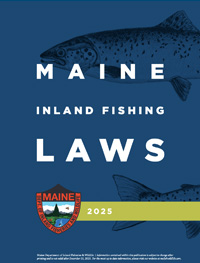Home → Fishing & Boating → Fishing → Laws & Rules → Aquatic Invasive Species
Aquatic Invasive Species

Help us Keep it Maine: Protect our waters from aquatic invasive species
Maine has some of the country’s most pristine and healthy waters, which support high-quality habitat for fish and wildlife as well as endless opportunities for outdoor recreation. On our inland waters, anglers can fish for native brook trout, Arctic charr, landlocked salmon, and lake trout, just to name a few.
Unfortunately, Maine waters, as well as the fish, wildlife, and recreation they support, are threatened each year by introductions of fish, plants, diseases, and other aquatic hitchhikers that compete with and displace native natural communities.
What can be done?
Once an invasive aquatic species has established in a body of water, it is extremely difficult for it to be eradicated. These efforts are costly, often risky, and not always successful and introductions have the potential to change our natural places and the way we enjoy them forever.
Therefore, prevention is key. So much of the spread comes from people simply enjoying the great outdoors. It’s our duty as those who enjoy using Maine’s waters to become informed, attentive, and accountable for our potential role in the spread of invasive species and to take steps to protect Maine’s waters.
Do your part: Protect Maine Waters from Aquatic Invasive Species
1 CLEAN
- Clean off plants, animals, and mud from gear and equipment including waders, footwear, ropes, anchors, bait traps, dip nets, downrigger cables, fishing lines, and field gear before leaving water access.
- Scrub off any visible material on footwear with a stiff brush.
- Dispose of debris in a trash reciprocal or a responsible location away from the water.
2 DRAIN
- Drain water from the watercraft prior to entering a waterbody and when preparing to leave a launch site.
- Maine law requires that prior to entering a water body and when preparing to leave launch sites, boaters must remove or open any devices designed for routine removal/opening (for example, hull drain plugs, bailers, live wells, ballast tanks) to encourage draining of areas containing water (excluding live bait containers). This must be done in a way that does not allow drained water to enter any inland water of the state.
- Boats should NOT be drained on the boat launch ramp. Since the transfer of aquatic invasive species to new areas within a water body can worsen the infestation, especially in high traffic launch areas, the preferred practice is to prevent direct draining back into the water body even when leaving the water body.
3 DRY
- Dry completely before reuse.
Under Maine law, you must immediately kill any fish that you decide to keep, and never transport any live fish (other than legal baitfish or rainbow smelt).
Never introduce fish or fish eggs into any inland water, including private, small, artificially constructed ponds, without a permit. MDIFW does issue permits to allow for safe and appropriate private pond stocking. Applicants must show that the stocking will not create adverse risks to native species, and that fish will come from pre-approved and licensed private hatcheries.
Make sure you are using legal baitfish species. See the Baitfish Information section for a quick guide to identifying legal and illegal species.
Don't dump your bait! Properly dispose of unused baitfish on land or in the trash. Never release any live baitfish into a water body. Dispose of unused worms in the trash, not in the water or on land.
Consider using non-felt soled boots to further reduce the risk of spreading aquatic invasive species. If you do use felt soled boots, thoroughly dry the boots and/or soak in a disinfecting solution before moving to another body of water.
If you see or suspect someone is moving live fish, contact the Maine Warden Service immediately at 1-800-ALERT-US or report the offense at MaineOGT.org.
For more information on invasive aquatic plants, please visit: maine.gov/dep/water/invasives.